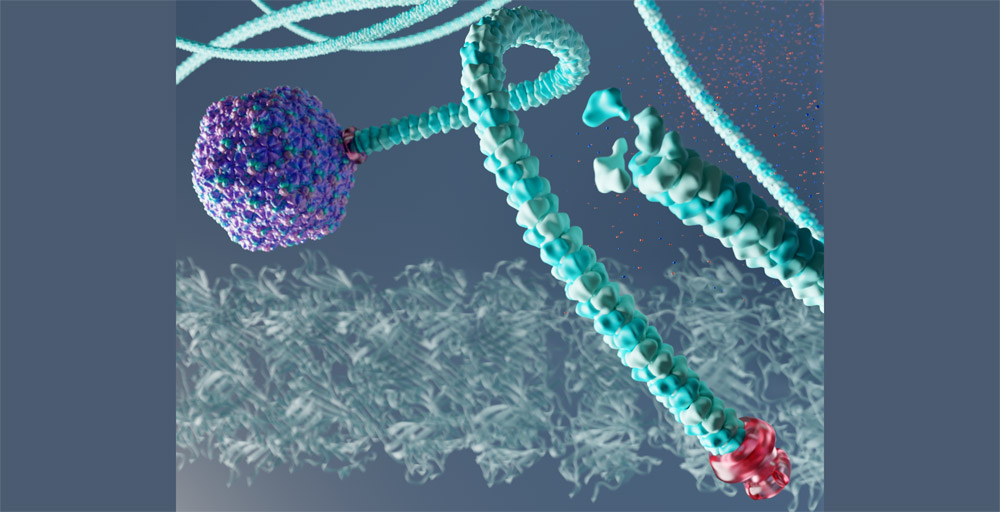
Evolutionary oddity: Found in hot pools, the P74-26 phage is doubly unique. Not only does it withstand temperatures in excess of 70 degrees – it also has the longest tail ever discovered in any virus. At p74-26, this insert, which is important for viral genome injection, is approximately 1 μm in length and has an extraordinarily stable structure. How a phage achieves this has now been closely examined by researchers for the first time – with results also relevant to the treatment of phages.
Viruses are the most common biological entity on our planet. Cell hackers occur in almost all habitats and all organisms, from the deep biosphere to oceans to mountain tops. Our bodies are also teeming with viruses. However, most of them are by no means pathogens, but completely harmless and even beneficial to us. Because they are phages – viruses that specialize in infecting bacteria.

“Bacteria are everywhere — in the water and dust around us, as well as in our bodies,” explains lead author Emily Agnello of the University of Massachusetts. Unlike viruses that infect our cells, phages have a tail-like appendage that they use to pierce the envelope of bacterial cells. Then they inject their genome into the infected cell through the cavity in the phage’s tail.
The Rapunzel devourer is very heat tolerant
But Agnello and her colleagues have now studied a phage that is very unusual even by phage standards. Phage P74-26 is a virus that occurs in hot pools and infects the bacteria that live there – that alone is strange. Because P74-26 is the only phage known so far that can withstand temperatures over 76 degrees in the long term.
Even more unusual, however, is the tail of these heat-tolerant viruses: in P74-26, this hollow, flexible appendage is nearly a micrometer long—about 10 times longer than most “long-tailed” phages. “Most cevoviruses have tail lengths between 50 and 1,200 nanometers,” the authors explain. The P74-26 clearly stands out from this. Its tail is longer than any other known virus. Therefore, the team named this virus the “Rapunzel virus”.
How does the phage tail remain stable?
To find out how P74-26’s tail is built and why it can remain stable even in such a hot environment, they cultured this bacterium in the lab. Using an electron cryometry error, they were able to capture many phages in action and watch these viruses gather their tails. The central component is the tail tube protein (TTP), which consists of many of the same basic units.
“Each phage tail is made up of many small building blocks that together make up the long tube,” explains Agnello. This consists of many superimposed protein loops, which are connected to each other by a kind of groove-and-flange system. “The construction principle is similar to that of Lego bricks, with the bricks having handles on one side and matching holes on the other,” explains Agnello’s colleague Brian Kelsch.
Bigger building blocks and tougher construction
However, unlike other phages, P74-26 uses larger base units as monomers for its tail. Each ring of this hollow structure consisted of only three units instead of six. As a result, this long tail is made up of larger, more stable building blocks. Perhaps this helps stabilize the tail of the phage even at higher temperatures,” explains Kelsch. The researchers suspect that these larger building blocks may have been created by a mutation in one of the ancestors of P74-26.
The analyzes also revealed that the tail of the p74-26 phage grows in a special way: only when the first three monomers form a ring to which the building blocks of the next ring can attach — and then only in a special shape and on one side. “Because the tail of P74-26 is so unusually long, there is a greater risk of defects and misfolded monomers,” the team explains. “Groove and flange geometry ensures reliable polymerization and minimizes defects.”
Also suitable for future phage treatments
However, the ‘Rapunzel’ P74-26 phage is not only interesting as an evolutionary oddity and exotic: such long-tailed phages could also be promising candidates for novel antibacterial therapies in medicine. Phages are already being tested as aids against stubborn and resistant germs. “By studying the assembly of phages, we can better understand how these viruses interact with bacteria,” explains Agnello.
Because the tails of phages are essential for host recognition and successful infection of the bacterial host, knowing how to design and optimize them can also help make phage treatments more effective. “Our model can explain with high precision the mechanism by which phages build long, stable tails,” the team says. (Journal of Biological Chemistry, 2023; doi: 10.1016/j.jbc.2023.103021)
Quelle: American Society of Biochemistry and Molecular Biology